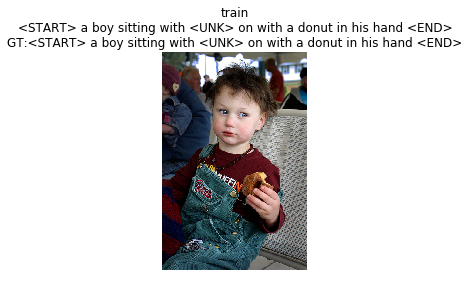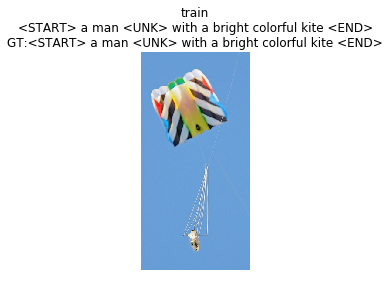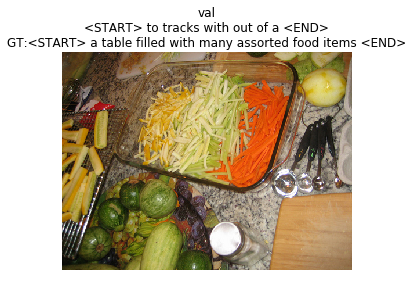来到最后一个作业,前两个作业仍然是使用numpy来实现一个rnn/lstm网络,后边三个作业则用到了tensorflow/pytorch,目前只用了tensorflow来完成,以后或许会把pytorch的也完成了。
前言
第一个任务是使用rnn来完成图像标注的任务。image caption是rnn类网络的经典应用,属于encoder-decoder网络,encoder使用cnn网络,如VGG16,采用softmax层前边的全连接层的向量作为图片表示,使用rnn类网络作为decoder,属于1对多的模型。
Show and Tell: A Neural Image Caption Generator
Show, Attend and Tell: Neural Image Caption Generation with Visual Attention
这两篇是图像标注的经典论文,上一篇在2015的coco比赛中拿到了第一名(因为他们用了很多trick),下一篇则引入attention机制,并介绍了soft attention和hard attention的区别。
作业
导入数据
encoder部分已经完成,采用softmax层之前的4096维向量的那一层,通过pca降维到512方便计算。
<START> 表示开始 <END>表示结束 <UNK> 表示未知 <NULL>填充短标题使用
val_urls <class 'numpy.ndarray'> (40504,) <U63
word_to_idx <class 'dict'> 1004
val_features <class 'numpy.ndarray'> (40504, 512) float32
train_urls <class 'numpy.ndarray'> (82783,) <U63
val_image_idxs <class 'numpy.ndarray'> (195954,) int32
train_image_idxs <class 'numpy.ndarray'> (400135,) int32
train_features <class 'numpy.ndarray'> (82783, 512) float32
val_captions <class 'numpy.ndarray'> (195954, 17) int32
idx_to_word <class 'list'> 1004
train_captions <class 'numpy.ndarray'> (400135, 17) int32



rnn前向过程
def rnn_step_forward(x, prev_h, Wx, Wh, b):
"""
Run the forward pass for a single timestep of a vanilla RNN that uses a tanh
activation function.
The input data has dimension D, the hidden state has dimension H, and we use
a minibatch size of N.
Inputs:
- x: Input data for this timestep, of shape (N, D).
- prev_h: Hidden state from previous timestep, of shape (N, H)
- Wx: Weight matrix for input-to-hidden connections, of shape (D, H)
- Wh: Weight matrix for hidden-to-hidden connections, of shape (H, H)
- b: Biases of shape (H,)
Returns a tuple of:
- next_h: Next hidden state, of shape (N, H)
- cache: Tuple of values needed for the backward pass.
"""
next_h, cache = None, None
##############################################################################
# TODO: Implement a single forward step for the vanilla RNN. Store the next #
# hidden state and any values you need for the backward pass in the next_h #
# and cache variables respectively. #
##############################################################################
temp1 = np.dot(x,Wx) # x(N,D) Wx(D,H) temp1(N,H) x的维度变为H
temp2 = np.dot(prev_h,Wh) # prev_h(N,H) Wh(H,H) temp2(N,H) 隐藏状态的维度不变
cache = (x,prev_h,Wx,Wh,temp1 + temp2 + b) #给反向传播用的东西
next_h = np.tanh(temp1 + temp2 + b) # 激活函数
##############################################################################
# END OF YOUR CODE #
##############################################################################
return next_h, cache
next_h error: 6.292421426471037e-09
rnn后向过程
def rnn_step_backward(dnext_h, cache):
"""
Backward pass for a single timestep of a vanilla RNN.
Inputs:
- dnext_h: Gradient of loss with respect to next hidden state, of shape (N, H)
- cache: Cache object from the forward pass
Returns a tuple of:
- dx: Gradients of input data, of shape (N, D)
- dprev_h: Gradients of previous hidden state, of shape (N, H)
- dWx: Gradients of input-to-hidden weights, of shape (D, H)
- dWh: Gradients of hidden-to-hidden weights, of shape (H, H)
- db: Gradients of bias vector, of shape (H,)
"""
dx, dprev_h, dWx, dWh, db = None, None, None, None, None
##############################################################################
# TODO: Implement the backward pass for a single step of a vanilla RNN. #
# #
# HINT: For the tanh function, you can compute the local derivative in terms #
# of the output value from tanh. #
##############################################################################
#h = tanh(Wh * prev_h + Wx * x + b)
x,h,Wx,Wh,cacheD = cache
N,H = h.shape
#计算激活函数tanh的导数 f(z)' = 1 − (f(z))**2
temp = np.ones((N,H)) - np.square(np.tanh(cacheD))
delta = np.multiply(temp,dnext_h)#乘以传过来的梯度
#计算x的梯度
tempx = np.dot(Wx,delta.T) #复合函数求导
dx = tempx.T
#计算h的梯度
temph = np.dot(Wh,delta.T)
dprev_h = temph.T
#计算Wxh的梯度
dWx = np.dot(x.T,delta)
#计算Whh的梯度
dWh = np.dot(h.T,delta)
#计算b的梯度
tempb = np.sum(delta,axis = 0)
db = tempb.T
##############################################################################
# END OF YOUR CODE #
##############################################################################
return dx, dprev_h, dWx, dWh, db
dx error: 4.0192769090159184e-10
dprev_h error: 2.5632975303201374e-10
dWx error: 8.820222259148609e-10
dWh error: 4.703287554560559e-10
db error: 7.30162216654e-11
rnn前向传播
def rnn_forward(x, h0, Wx, Wh, b):
"""
Run a vanilla RNN forward on an entire sequence of data. We assume an input
sequence composed of T vectors, each of dimension D. The RNN uses a hidden
size of H, and we work over a minibatch containing N sequences. After running
the RNN forward, we return the hidden states for all timesteps.
Inputs:
- x: Input data for the entire timeseries, of shape (N, T, D).
- h0: Initial hidden state, of shape (N, H)
- Wx: Weight matrix for input-to-hidden connections, of shape (D, H)
- Wh: Weight matrix for hidden-to-hidden connections, of shape (H, H)
- b: Biases of shape (H,)
Returns a tuple of:
- h: Hidden states for the entire timeseries, of shape (N, T, H).
- cache: Values needed in the backward pass
"""
h, cache = None, None
##############################################################################
# TODO: Implement forward pass for a vanilla RNN running on a sequence of #
# input data. You should use the rnn_step_forward function that you defined #
# above. You can use a for loop to help compute the forward pass. #
##############################################################################
N,T,D = x.shape
H = h0.shape[1]
prev_h = h0
h1 = np.empty([N,T,H])
h2 = np.empty([N,T,H])
h3 = np.empty([N,T,H])
for i in range(T):
temp_h,cache_temp = rnn_step_forward(x[:,i,:],prev_h,Wx,Wh,b) #前向传播
h3[:,i,:] = prev_h #前一个隐藏层的状态
prev_h = temp_h
h2[:,i,:] = temp_h #当前隐藏层的状态
h1[:,i,:] = cache_temp[4] #tanh函数里边的东西
cache = (x,h3,Wx,Wh,h1)
##############################################################################
# END OF YOUR CODE #
##############################################################################
return h2, cache
h error: 7.728466158305164e-08
rnn后向传播
def rnn_backward(dh, cache):
"""
Compute the backward pass for a vanilla RNN over an entire sequence of data.
Inputs:
- dh: Upstream gradients of all hidden states, of shape (N, T, H).
NOTE: 'dh' contains the upstream gradients produced by the
individual loss functions at each timestep, *not* the gradients
being passed between timesteps (which you'll have to compute yourself
by calling rnn_step_backward in a loop).
Returns a tuple of:
- dx: Gradient of inputs, of shape (N, T, D)
- dh0: Gradient of initial hidden state, of shape (N, H)
- dWx: Gradient of input-to-hidden weights, of shape (D, H)
- dWh: Gradient of hidden-to-hidden weights, of shape (H, H)
- db: Gradient of biases, of shape (H,)
"""
dx, dh0, dWx, dWh, db = None, None, None, None, None
##############################################################################
# TODO: Implement the backward pass for a vanilla RNN running an entire #
# sequence of data. You should use the rnn_step_backward function that you #
# defined above. You can use a for loop to help compute the backward pass. #
##############################################################################
x = cache[0]
N,T,D = x.shape
N,T,H = dh.shape
dWx = np.zeros((D,H))
dWh = np.zeros((H,H))
db = np.zeros(H)
dout = dh
dx = np.empty([N,T,D])
dh = np.empty([N,T,H])
hnow = np.zeros([N,H]) #当前时刻隐藏状态对应的梯度
for k in range(T):
i = T - 1 - k
hnow = hnow + dout[:,i,:] #除了上一层传来的梯度,我们每一层都有输出,对应的误差函数也会传入梯度
cacheT = (cache[0][:,i,:],cache[1][:,i,:],cache[2],cache[3],cache[4][:,i,:])
dx_temp,dprev_h,dWx_temp,dWh_temp,db_temp = rnn_step_backward(hnow,cacheT)
hnow = dprev_h
dx[:,i,:] = dx_temp
dWx = dWx + dWx_temp
dWh = dWh + dWh_temp
db = db + db_temp
dh0 = hnow
##############################################################################
# END OF YOUR CODE #
##############################################################################
return dx, dh0, dWx, dWh, db
dx error: 1.5382468491701097e-09
dh0 error: 3.3839681556240896e-09
dWx error: 7.150535245339328e-09
dWh error: 1.297338408201546e-07
db error: 1.4889022954777414e-10
词向量前向传播
词向量同样是需要训练的
def word_embedding_forward(x, W):
"""
Forward pass for word embeddings. We operate on minibatches of size N where
each sequence has length T. We assume a vocabulary of V words, assigning each
word to a vector of dimension D.
Inputs:
- x: Integer array of shape (N, T) giving indices of words. Each element idx
of x muxt be in the range 0 <= idx < V.
- W: Weight matrix of shape (V, D) giving word vectors for all words.
Returns a tuple of:
- out: Array of shape (N, T, D) giving word vectors for all input words.
- cache: Values needed for the backward pass
"""
out, cache = None, None
##############################################################################
# TODO: Implement the forward pass for word embeddings. #
# #
# HINT: This can be done in one line using NumPy's array indexing. #
##############################################################################
out = W[x,:]
cache = (x,W)
##############################################################################
# END OF YOUR CODE #
##############################################################################
return out, cache
out error: 1.0000000094736443e-08
词向量后向传播
def word_embedding_backward(dout, cache):
"""
Backward pass for word embeddings. We cannot back-propagate into the words
since they are integers, so we only return gradient for the word embedding
matrix.
HINT: Look up the function np.add.at
Inputs:
- dout: Upstream gradients of shape (N, T, D)
- cache: Values from the forward pass
Returns:
- dW: Gradient of word embedding matrix, of shape (V, D).
"""
dW = None
##############################################################################
# TODO: Implement the backward pass for word embeddings. #
# #
# Note that words can appear more than once in a sequence. #
# HINT: Look up the function np.add.at #
##############################################################################
x,W = cache
dW = np.zeros_like(W)
np.add.at(dW,x,dout) #在x指定的位置将dout加到dW上
##############################################################################
# END OF YOUR CODE #
##############################################################################
return dW
dW error: 3.2774595693100364e-12
仿射层
使用仿射函数将该时间步中的RNN隐藏向量转换为词汇表中每个单词的得分。
def temporal_affine_forward(x, w, b):
"""
Forward pass for a temporal affine layer. The input is a set of D-dimensional
vectors arranged into a minibatch of N timeseries, each of length T. We use
an affine function to transform each of those vectors into a new vector of
dimension M.
Inputs:
- x: Input data of shape (N, T, D)
- w: Weights of shape (D, M)
- b: Biases of shape (M,)
Returns a tuple of:
- out: Output data of shape (N, T, M)
- cache: Values needed for the backward pass
"""
N, T, D = x.shape
M = b.shape[0]
out = x.reshape(N * T, D).dot(w).reshape(N, T, M) + b
cache = x, w, b, out
return out, cache
def temporal_affine_backward(dout, cache):
"""
Backward pass for temporal affine layer.
Input:
- dout: Upstream gradients of shape (N, T, M)
- cache: Values from forward pass
Returns a tuple of:
- dx: Gradient of input, of shape (N, T, D)
- dw: Gradient of weights, of shape (D, M)
- db: Gradient of biases, of shape (M,)
"""
x, w, b, out = cache
N, T, D = x.shape
M = b.shape[0]
dx = dout.reshape(N * T, M).dot(w.T).reshape(N, T, D)
dw = dout.reshape(N * T, M).T.dot(x.reshape(N * T, D)).T
db = dout.sum(axis=(0, 1))
return dx, dw, db
dx error: 2.9215945034030545e-10
dw error: 1.5772088618663602e-10
db error: 3.252200556967514e-11
仿射层的损失函数-softmax
def temporal_softmax_loss(x, y, mask, verbose=False):
"""
A temporal version of softmax loss for use in RNNs. We assume that we are
making predictions over a vocabulary of size V for each timestep of a
timeseries of length T, over a minibatch of size N. The input x gives scores
for all vocabulary elements at all timesteps, and y gives the indices of the
ground-truth element at each timestep. We use a cross-entropy loss at each
timestep, summing the loss over all timesteps and averaging across the
minibatch.
As an additional complication, we may want to ignore the model output at some
timesteps, since sequences of different length may have been combined into a
minibatch and padded with NULL tokens. The optional mask argument tells us
which elements should contribute to the loss.
Inputs:
- x: Input scores, of shape (N, T, V)
- y: Ground-truth indices, of shape (N, T) where each element is in the range
0 <= y[i, t] < V
- mask: Boolean array of shape (N, T) where mask[i, t] tells whether or not
the scores at x[i, t] should contribute to the loss.
Returns a tuple of:
- loss: Scalar giving loss
- dx: Gradient of loss with respect to scores x.
"""
N, T, V = x.shape
x_flat = x.reshape(N * T, V)
y_flat = y.reshape(N * T)
mask_flat = mask.reshape(N * T)
probs = np.exp(x_flat - np.max(x_flat, axis=1, keepdims=True))
probs /= np.sum(probs, axis=1, keepdims=True)
loss = -np.sum(mask_flat * np.log(probs[np.arange(N * T), y_flat])) / N
dx_flat = probs.copy()
dx_flat[np.arange(N * T), y_flat] -= 1
dx_flat /= N
dx_flat *= mask_flat[:, None]
if verbose: print('dx_flat: ', dx_flat.shape)
dx = dx_flat.reshape(N, T, V)
return loss, dx
2.3027781774290146
23.025985953127226
2.2643611790293394
dx error: 2.583585303524283e-08
损失函数
def loss(self, features, captions):
"""
计算训练时RNN/LSTM的损失函数。我们输入图像特征和正确的图片注释,使用RNN/LSTM计算损失函数和所有参数的梯度
输入:
- features: 输入图像特征,维度 (N, D)
- captions: 正确的图像注释; 维度为(N, T)的整数列
输出一个tuple:
- loss: 标量损失函数值
- grads: 所有参数的梯度
"""
#这里将captions分成了两个部分,captions_in是除了最后一个词外的所有词,是输入到RNN/LSTM的输入;
#captions_out是除了第一个词外的所有词,是RNN/LSTM期望得到的输出。
captions_in = captions[:, :-1]
captions_out = captions[:, 1:]
# You'll need this
mask = (captions_out != self._null)
# 从图像特征到初始隐藏状态的权值矩阵和偏差值
W_proj, b_proj = self.params['W_proj'], self.params['b_proj']
# 词嵌入矩阵
W_embed = self.params['W_embed']
# RNN/LSTM参数
Wx, Wh, b = self.params['Wx'], self.params['Wh'], self.params['b']
# 每一隐藏层到输出的权值矩阵和偏差
W_vocab, b_vocab = self.params['W_vocab'], self.params['b_vocab']
loss, grads = 0.0, {}
############################################################################
# TODO: Implement the forward and backward passes for the CaptioningRNN. #
# In the forward pass you will need to do the following: #
# (1) Use an affine transformation to compute the initial hidden state #
# from the image features. This should produce an array of shape (N, H)#
# (2) Use a word embedding layer to transform the words in captions_in #
# from indices to vectors, giving an array of shape (N, T, W). #
# (3) Use either a vanilla RNN or LSTM (depending on self.cell_type) to #
# process the sequence of input word vectors and produce hidden state #
# vectors for all timesteps, producing an array of shape (N, T, H). #
# (4) Use a (temporal) affine transformation to compute scores over the #
# vocabulary at every timestep using the hidden states, giving an #
# array of shape (N, T, V). #
# (5) Use (temporal) softmax to compute loss using captions_out, ignoring #
# the points where the output word is <NULL> using the mask above. #
# #
# In the backward pass you will need to compute the gradient of the loss #
# with respect to all model parameters. Use the loss and grads variables #
# defined above to store loss and gradients; grads[k] should give the #
# gradients for self.params[k]. #
# #
# Note also that you are allowed to make use of functions from layers.py #
# in your implementation, if needed. #
############################################################################
N,D = features.shape
#(1) 用线性变换从图像特征值得到初始隐藏状态,将产生维度为(N,H)的数列
out,cache_affine = temporal_affine_forward(features.reshape(N,1,D),W_proj,b_proj)
N,T,H = out.shape
h0 = out.reshape(N,H)
#(2) 用词嵌入层将captions_in中词的索引转换成词向量,得到一个维度为(N, T, W)的数列
word_out,cache_word = word_embedding_forward(captions_in,W_embed)
#(3) 用RNN/LSTM处理输入的词向量,产生每一层的隐藏状态,维度为(N,T,H)
if self.cell_type == 'rnn':
hidden,cache_hidden = rnn_forward(word_out,h0,Wx,Wh,b)
else:
hidden,cache_hidden = lstm_forward(word_out,h0,Wx,Wh,b)
#(4) 用线性变换计算每一步隐藏层对应的输出(得分),维度(N, T, V)
out_vo,cache_vo = temporal_affine_forward(hidden,W_vocab,b_vocab)
#(5) 用softmax函数计算损失,真实值为captions_out, 用mask忽视所有向量中<NULL>词汇
loss,dx = temporal_softmax_loss(out_vo[:,:,:],captions_out,mask,verbose = False)
#反向传播,得到对应参数
dx_affine,dW_vocab,db_vocab = temporal_affine_backward(dx,cache_vo)
grads['W_vocab'] = dW_vocab
grads['b_vocab'] = db_vocab
if self.cell_type == 'rnn':
dx_hidden,dh0,dWx,dWh,db = rnn_backward(dx_affine,cache_hidden)
else:
dx_hidden,dh0,dWx,dWh,db = lstm_backward(dx_affine,cache_hidden)
grads['Wx'] = dWx
grads['Wh'] = dWh
grads['b'] = db
dW_embed = word_embedding_backward(dx_hidden,cache_word)
grads['W_embed'] = dW_embed
dx_initial,dW_proj,db_proj = temporal_affine_backward(dh0.reshape(N,T,H),cache_affine)
grads['W_proj'] = dW_proj
grads['b_proj'] = db_proj
############################################################################
# END OF YOUR CODE #
############################################################################
return loss, grads
loss: 9.832355910027387
expected loss: 9.83235591003
difference: 2.6130209107577684e-12
W_embed relative error: 2.331070e-09
W_proj relative error: 1.112417e-08
W_vocab relative error: 4.274379e-09
Wh relative error: 5.858117e-09
Wx relative error: 1.590657e-06
b relative error: 9.727211e-10
b_proj relative error: 1.934807e-08
b_vocab relative error: 7.087097e-11
尝试来过拟合一个小数据集
(Iteration 1 / 100) loss: 76.913487
(Iteration 11 / 100) loss: 21.063245
(Iteration 21 / 100) loss: 4.016209
(Iteration 31 / 100) loss: 0.567061
(Iteration 41 / 100) loss: 0.239461
(Iteration 51 / 100) loss: 0.162024
(Iteration 61 / 100) loss: 0.111548
(Iteration 71 / 100) loss: 0.097589
(Iteration 81 / 100) loss: 0.099104
(Iteration 91 / 100) loss: 0.073981

Success!
测试阶段的sample
在这个任务当中,在训练阶段,rnn每一步的输入都是ground truth,而在测试阶段,rnn每一步的都是则是通过beam search搜索出的word,经过一步步的生成,很可能把一个错误给放大。
Show and Tell: A Neural Image Caption Generator这篇论文中的方法是,在训练阶段,随机地使用生成的词而非ground truth的词,作者认为这样可以强迫模型学会如何处理错误。
这一部分就是展示这一区别
def sample(self, features, max_length=30):
"""
Run a test-time forward pass for the model, sampling captions for input
feature vectors.
At each timestep, we embed the current word, pass it and the previous hidden
state to the RNN to get the next hidden state, use the hidden state to get
scores for all vocab words, and choose the word with the highest score as
the next word. The initial hidden state is computed by applying an affine
transform to the input image features, and the initial word is the <START>
token.
For LSTMs you will also have to keep track of the cell state; in that case
the initial cell state should be zero.
输入:
- captions: 输入图像特征,维度 (N, D)
- max_length: 生成的注释的最长长度
输出:
- captions: 采样得到的注释,维度(N, max_length), 每个元素是词汇的索引
"""
N = features.shape[0]
captions = self._null * np.ones((N, max_length), dtype=np.int32)
# Unpack parameters
W_proj, b_proj = self.params['W_proj'], self.params['b_proj']
W_embed = self.params['W_embed']
Wx, Wh, b = self.params['Wx'], self.params['Wh'], self.params['b']
W_vocab, b_vocab = self.params['W_vocab'], self.params['b_vocab']
###########################################################################
# TODO: Implement test-time sampling for the model. You will need to #
# initialize the hidden state of the RNN by applying the learned affine #
# transform to the input image features. The first word that you feed to #
# the RNN should be the <START> token; its value is stored in the #
# variable self._start. At each timestep you will need to do to: #
# (1) Embed the previous word using the learned word embeddings #
# (2) Make an RNN step using the previous hidden state and the embedded #
# current word to get the next hidden state. #
# (3) Apply the learned affine transformation to the next hidden state to #
# get scores for all words in the vocabulary #
# (4) Select the word with the highest score as the next word, writing it #
# (the word index) to the appropriate slot in the captions variable #
# #
# For simplicity, you do not need to stop generating after an <END> token #
# is sampled, but you can if you want to. #
# #
# HINT: You will not be able to use the rnn_forward or lstm_forward #
# functions; you'll need to call rnn_step_forward or lstm_step_forward in #
# a loop. #
# #
# NOTE: we are still working over minibatches in this function. Also if #
# you are using an LSTM, initialize the first cell state to zeros. #
###########################################################################
# (1)用线性变换从图像特征值得到初始隐藏状态,将产生维度为(N,H)的数列
N,D = features.shape
out,cache_affine = temporal_affine_forward(features.reshape(N,1,D),W_proj,b_proj)
N,T,H = out.shape
h0 = out.reshape(N,H)
h = h0
#初始输入
x0 = W_embed[[1,1],:]
x_input = x0
captions[:,0] = [1,1]
prev_c = np.zeros_like(h) # only for lstm
#(2) 执行rnn/lstm步骤
for i in range(max_length - 1):
if self.cell_type == 'rnn':
next_h,_ = rnn_step_forward(x_input,h,Wx,Wh,b)
else:
next_h,next_c,cache = lstm_step_forward(x_input,h,prev_c,Wx,Wh,b)
prev_c = next_c
#(3) 计算每一层的输出
out_vo,cache_vo = temporal_affine_forward(next_h.reshape(N,1,H),W_vocab,b_vocab)
#(4) 找到输出最大值的项作为下一时刻的输入
index = np.argmax(out_vo,axis = 2)
x_input = np.squeeze(W_embed[index,:])
h = next_h
captions[:,i+1] = np.squeeze(index)#记录其索引
############################################################################
# END OF YOUR CODE #
############################################################################
return captions




很清楚地展示了这一区别。
思考问题是关于word级别的分词和character级别的分词的区别,各自的优点和缺点。事实上现在关于各种语言的分词研究还是很活跃的。